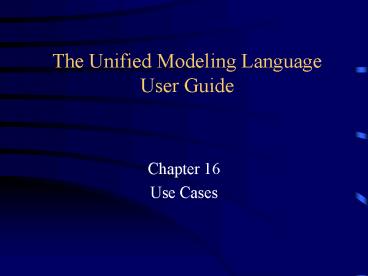The Unified Modeling Language User Guide - PowerPoint PPT Presentation
1 / 13
Title:
The Unified Modeling Language User Guide
Description:
... typically represented as a stick figure of a person labeled ... May be drawn as a stick figure, stereotyped class or a graphical image of your own design. ... – PowerPoint PPT presentation
Number of Views:195
Avg rating:3.0/5.0
Title: The Unified Modeling Language User Guide
1
The Unified Modeling Language User Guide
- Chapter 16
- Use Cases
2
Chapter 16 Topics
- Introduction
- Terms and Concepts
3
Introduction
- A use case ...
- Specifies the behavior of a system or some subset
of a system. - Is a system-level function.
- Does not indicative how the specified behavior is
implemented, only what the behavior is. - Performs a service for some user of the system.
- A user of the system is known as an actor.
- An actor can be a person or another system.
- During the analysis phase, facilitates
communication between the users of the system and
the developers of the system.
4
Introduction
5
Introduction
- A use case ...
- Represents a functional requirement of the system
as a whole. - Is graphically represented as an oval with the
name of its functionality written inside. - Functionality is always expressed as a verb or a
verb phrase. - An actor is most typically represented as a stick
figure of a person labeled with its role name. - Individual use cases can exist in relationships
with other use cases much in the same way as
classes maintain relationships with other classes.
6
Terms and Concepts
- Names are used to distinguish one use case from
another. - Actors
- May be drawn as a stick figure, stereotyped class
or a graphical image of your own design. - Are connected to use cases by associations.
- May be involved in generalization relationships
with other actors. - Exist outside the system boundaries.
7
Terms and Concepts
8
Terms and Concepts
- Use cases and Flow of Events
- A use case, by itself, does not describe the flow
of events needed to carry out the use case. - Flow of events can be described using informal
text, pseudocode, or activity diagrams. - Be sure to address exception handling when
describing flow of events. - Use a note to attach flow of events documentation
to a use case.
9
Use cases and CollaborationsCollaboration
diagrams show which classes are involved in
implementing a particular use case.
10
Terms and Concepts
- Organizing Use Cases
- Packages may be used to organize (group) use
cases. - Generalization between use cases is used to
extend the behavior of a parent use case. - An ltltincludegtgt relationship between use cases
means that the base use case explicitly
incorporates the behavior of another use case at
a location specified in the base. - Sometimes the ltltusesgt stereotype is used instead
of ltltincludegtgt.
11
Terms and Concepts
- Organizing Use Cases
- An ltltextendgtgt relationship between use cases
means that the base use case implicitly
incorporates the behavior of another use case at
a location specified indirectly by the extending
use case. - Extended behavior is optional behavior, while
included behavior is required behavior.
12
Use Case Relationships
13
Use Case Relationships































